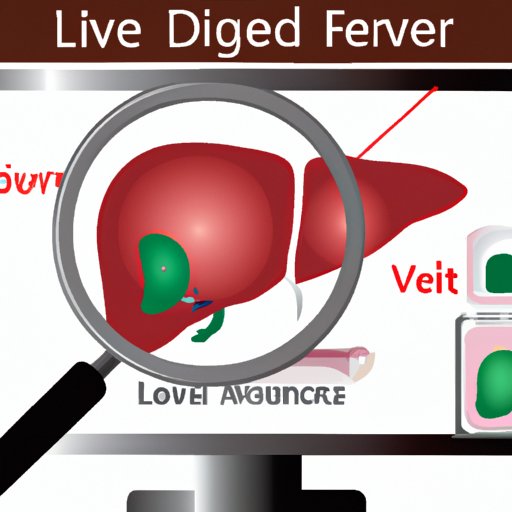
Introduction
Liver disease is a serious condition that affects millions of people worldwide. In fact, the American Liver Foundation estimates that approximately 30 million Americans have some form of liver disease. Early diagnosis and treatment of liver disease are crucial for preventing further damage to the liver and improving overall health. This article aims to provide readers with a comprehensive guide to diagnosing liver disease, including common symptoms, liver function tests, staging, imaging, and liver biopsy.
10 Common Symptoms of Liver Disease You Shouldn’t Ignore
The liver is responsible for filtering harmful toxins from the body, producing bile to aid in digestion, and regulating various hormones. When the liver is damaged or not functioning properly, it can lead to a wide range of symptoms. The following are 10 of the most common symptoms of liver disease:
- Jaundice
- Abdominal pain and swelling
- Fatigue and weakness
- Nausea and vomiting
- Loss of appetite
- Dark urine
- Pale stool
- Itchy skin
- Muscle and joint pain
- Mental confusion
It is important to note that not all people with liver disease will experience these symptoms, and some symptoms may not appear until the disease has progressed. If you are experiencing any of these symptoms, it is recommended to seek medical attention promptly to prevent further liver damage.
Understanding Liver Function Tests: A Guide to Diagnosing Liver Disease
Liver function tests (LFTs) are blood tests that assess how well the liver is functioning. These tests measure the levels of various enzymes, proteins, and other substances in the blood. Abnormal levels can indicate liver damage or disease. The most common LFTs include:
- Alanine aminotransferase (ALT)
- Aspartate aminotransferase (AST)
- Alkaline phosphatase (ALP)
- Bilirubin
LFTs can also be used to monitor the effectiveness of treatment for liver disease. However, it is important to note that LFTs alone cannot diagnose liver disease, and further testing may be necessary.
How to Identify the Different Stages of Liver Disease
Liver disease can progress through several stages, with each stage having its own set of symptoms and markers. The following are the four stages of liver disease:
- Stage 1: Inflammation and mild scarring
- Stage 2: Moderate scarring
- Stage 3: Severe scarring (cirrhosis)
- Stage 4: Liver failure
Common symptoms of liver disease in each stage include:
- Stage 1: Fatigue, mild abdominal pain, and elevated liver enzymes
- Stage 2: Jaundice, abdominal swelling, and easy bruising
- Stage 3: Ascites (abdominal fluid buildup), confusion, and muscle wasting
- Stage 4: Coma and hepatic encephalopathy (brain dysfunction due to liver failure)
Understanding the stages of liver disease is crucial for accurately diagnosing and treating the condition. This is why it is important to get regular check-ups and liver function tests if you are at risk for liver disease or have a history of liver damage.
The Role of Imaging in Diagnosing Liver Disease
Imaging tests can help detect liver damage and disease, including cirrhosis, tumors, and abnormal blood vessels. The following are the most common types of imaging used to diagnose liver disease:
- Ultrasound
- Computed tomography (CT) scan
- Magnetic resonance imaging (MRI)
Imaging tests can also be used to monitor the progression of liver disease and the effectiveness of treatment. However, imaging tests alone cannot diagnose liver disease, and further testing may be necessary.
Liver Biopsy 101: What to Expect and Why It’s Important for Diagnosis
A liver biopsy is a procedure in which a small piece of liver tissue is removed and examined under a microscope. This can help diagnose liver disease, determine the stage and severity of the disease, and identify any underlying causes. You may be a candidate for a liver biopsy if you have abnormal liver function tests or imaging results, or if your doctor suspects that you may have liver disease.
The procedure typically takes less than an hour and is performed under local anesthesia. During the procedure, a needle is inserted through the skin into the liver to obtain a small tissue sample. You may feel some pressure or discomfort during the procedure, but it is generally well-tolerated. It is important to follow any instructions provided by your doctor before and after the procedure to reduce the risk of complications.
Conclusion
Liver disease is a serious condition that can lead to significant health problems if left untreated. Early detection and accurate diagnosis are crucial for preventing further liver damage and improving overall health. If you are experiencing symptoms of liver disease or are at risk for the condition, it is important to seek medical attention promptly. Your doctor can perform liver function tests, imaging tests, and even a liver biopsy if necessary to accurately diagnose and treat liver disease.




